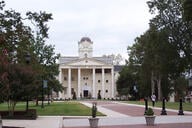You have /5 articles left.
Sign up for a free account or log in.
College endowments saw double-digit investment returns in the 2013 budget year, a year after they shrank slightly.
That’s the good news from a survey of 461 American colleges by Commonfund and the National Association of College and University Business Officers, or NACUBO.
The bad news is that 2013's nifty investment return – 11.7 percent growth from summer 2012 to summer 2013 – is probably not the new normal. Instead, business officers may want to plan for sagging returns.
Still, the 2013 return of nearly 12 percent is better than that of the 2012 budget year. During the 2012 budget cycle, college endowment investments actually lost 0.3 percent.
Kenneth Redd, director of research and policy analysis at NACUBO, said college business officers are not really rejoicing about the 2013 gains because they know their 10-year average return is 7.1 percent.
“In the long term, it’s O.K. but not great: you really do need long-term growth to keep the endowment to last into perpetuity,” he said. “Treading water is better than shrinking but it’s not as good as growing.”
Redd said colleges need to see annual returns of about 9 percent to actually increase their endowments because they typically spend about 5 percent of their fund each year on things like financial aid, and they have to keep up with inflation. Because the decade was punctured by the recession, institutions have been largely unable to add to their principals.
In the 2013 budget year, college officials still spent money at about the same rate -- 5 percent of the endowment size -- as they had in the past to support financial aid and other things despite seeing negative returns in 2012. To do that, colleges had to spend endowment principal.
“They are continuing to spend to support the mission, which is very encouraging to watch,” said Bill Jarvis, the managing director of the Commonfund Institute, which advises nonprofit investors.
But Jarvis said he found it remarkable that colleges have yet to adjust their annual spending rates to the new reality of lower annual returns, which Redd said could be 6-7 percent for the foreseeable future.
Donor giving appears to be up, on average, according to the survey. During the 2012 budget cycle, about 40 percent of endowments reported an increase in gifts, while about 40 percent reported a decrease. In 2013, a full half of endowments saw an increase in gifts, while only a third reported a decline.
The survey results are preliminary and therefore incomplete. The final survey will include about twice as many colleges, including a few outside of the United States. But the results should not change much, Redd said.
One of the trends Redd and Jarvis are eyeing is a possible decline in the portion of an endowment’s investment portfolio devoted to so-called alternative investments, including hedge funds, real estate and private equity. These investments are generally harder to quickly liquidate and, since the recession, have had poor returns compared to domestic and international stocks.
The report does not break out returns by institution, but some institutions have separately touted their own returns in recent weeks, including Harvard University (11.3 percent return), Columbia University (11.5 percent), the University of Notre Dame (11.8 percent), Yale University (12.5 percent) and Duke University (13.5 percent).




